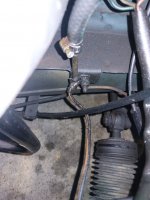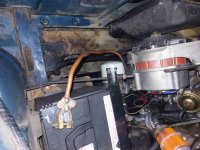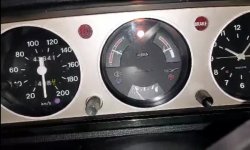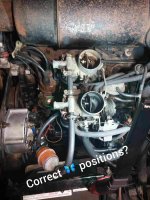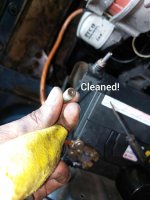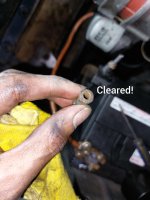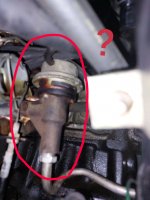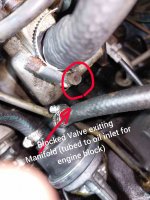504s originally came with a 35 amp alternator so I can't see how an 80 amp will help.No luck I'm afraid fellas. Same issue, lights on, revs drop, car stalls. Goes okay with lights on. I did replace the alternator to a 80A instead of 60A when I first received the car, would this make any difference? I might change the setup as Neil has suggested. Did wan;t to keep it as close to stock as possible, but this is becoming a real pain in the rear end.

You are using an out of date browser. It may not display this or other websites correctly.
You should upgrade or use an alternative browser.
You should upgrade or use an alternative browser.
504 Stalling Issue
- Thread starter James Gelido
- Start date
Hi Jim, I have adjusted pivot rods parallel to top gasket face, per the manual spec. No luck, unfortunately. Earth wires seem okay, apart from some oil, see attached. Will try give them a good clean tomorrow. CheersAs in whippets post 33 the float pivot rods should be parallel to carry top gasket face otherwise floats will pivot through an arc and may stick/jam in fuel bowl.also on electrical side does it have a good earth wire body to engine?usually a cable from bell housing l/hand dust cover upper mount bolt to chassis/body,if no cable body to engine then can result in electrical breakdown under load,usually when starting or with lights,heater fan and other items on…jim
Attachments
504s originally came with a 35 amp alternator so I can't see how an 80 amp will hel
504s originally came with a 35 amp alternator so I can't see how an 80 amp will help.
The volt metre on the dash shows bang in the middle when idling, so not overcharging. When the car is in 3rd, especially down a hill, with lights on, the volts drop to the high point range of 'red'. Also, the head lights are quite hot when running ..... is this normal?
Attachments
I'll give that a go tomorrow. Thanks PeterThe connections in the two pics look suspect. I suggest unbolting those connections, giving them a thorough clean including a scrub wire a wire brush before screwing the lot back together.
Hi James,The volt metre on the dash shows bang in the middle when idling, so not overcharging. When the car is in 3rd, especially down a hill, with lights on, the volts drop to the high point range of 'red'. Also, the head lights are quite hot when running ..... is this normal?
Does the voltage drop to the same point red range when head lights are on, but the car isn't running?
If it is, it would suggest the battery is weak. But if the battery was this weak, the car should have problems starting.
The other option is that the alternator is not keeping up when the lights are on, and allowing the battery to discharge. What wattage light globes are fitted at the moment?
As well as checking the earths, suggest have a look at the brushes and diodes on the alternator to see if anything is obviously amiss.
Perhaps the simplest way to eliminate that alternator as a problem is to swap it with a known good one. A spare, good alternator on the shelf is cheap insurance IMO.
Cheers,
Andrew
Hi.
As I am not familiar with this engine or carburettor set up I did some internet searching. It seems that the twin Solex carburettor’s are configured as a progressive primary and secondary arrangement - similar to the image below with red background?. Therefore all of the idle fuel circuits are in the primary carburettor - the one on the left in the image. This explains the missing brass tube and orifice in the image in post #29.
In post #5 baldrick56 mentions engine load. In other posts you have mentioned that the engine stalls when the auto transmission is in gear and when the headlights are switched on. I think that the (completely normal) load that torque converter and the alternator is demanding from the engine is a factor in the stalling.
In post #15 you mention that turning the idle mixture screw in or out does not affect the engine idle speed or consistency of idling - it should.
In post #27 you mention that the idle improves when you apply half choke - for me this and post #15 is a significant piece of diagnostic information.
In post #27 I suggested that the problem is a lean idle fuel mixture provided by the idle circuit. I still consider that is the root cause of the stalling.
As the engine is idling with a lean fuel mixture any additional load ie from the alternator, is causing the stalling.
So what can contribute to a lean idle fuel mixture? I have listed these in decending order of probability.
* Be careful that you don't touch any other earth on the engine or carburettor with the 12V wire as there will be lots of sparks.
Cheers.

As I am not familiar with this engine or carburettor set up I did some internet searching. It seems that the twin Solex carburettor’s are configured as a progressive primary and secondary arrangement - similar to the image below with red background?. Therefore all of the idle fuel circuits are in the primary carburettor - the one on the left in the image. This explains the missing brass tube and orifice in the image in post #29.
In post #5 baldrick56 mentions engine load. In other posts you have mentioned that the engine stalls when the auto transmission is in gear and when the headlights are switched on. I think that the (completely normal) load that torque converter and the alternator is demanding from the engine is a factor in the stalling.
In post #15 you mention that turning the idle mixture screw in or out does not affect the engine idle speed or consistency of idling - it should.
In post #27 you mention that the idle improves when you apply half choke - for me this and post #15 is a significant piece of diagnostic information.
In post #27 I suggested that the problem is a lean idle fuel mixture provided by the idle circuit. I still consider that is the root cause of the stalling.
As the engine is idling with a lean fuel mixture any additional load ie from the alternator, is causing the stalling.
So what can contribute to a lean idle fuel mixture? I have listed these in decending order of probability.
- Does this engine have an Exhaust Gas Recirculation (EGR) valve? If so these can become sticky and allow exhaust gas to enter the inlet manifold which will dilute the fuel mixture at idle. If it has one you need to check it is functioning correctly. Depending on the design you might be able to spray some penetrating lubricant WD40 etc onto the rod that controls the pintle.
- Air leaks into the inlet manifold. It seems that you have checked hoses, and gaskets, so I will assume that all is in order here.
- The throttle butterfly in the secondary carburettor needs to be adjusted with the stop, so that the butterfly is just on the point of touching the bore. ie no airflow at idle.
- Worn throttle butterfly valve shaft, this can allow air to bypass the butterfly disc. Check that there is no excessive side movement on the throttle shaft through the body.
- The image below shows a solenoid (just above the return spring on the throttle shaft), this is a solenoid to cut the fuel supply from the idle circuit to prevent run-on when the ignition is turned off. With the engine idling, remove the wire to it and and the engine should stop. If not, with the engine stopped, remove the wire, and *apply an independent 12V supply from the battery positive. You should be able to hear the solenoid "click" when you touch and remove the 12V. If no click you need to check this for correct operation.
- If no joy from above, then you need to ensure that the idle jet in the carburettor is not blocked. Note this is a different jet to the main jets.
- Vacuum advance. A long shot here. I don't have specific knowledge of this engine, but on other engines often the carburettor for automatic transmissions applied the full vacuum advance when the engine was idling, to compensate for the load the automatic transmission demanded from the engine. Maybe remove the vacuum supply tubing from the advance on the distributor to check for this???
* Be careful that you don't touch any other earth on the engine or carburettor with the 12V wire as there will be lots of sparks.
Cheers.
Have you checked the inlet manifold for flatness?
Actually for any air leaks around there the trick is to start the engine and then spray something volatile like start ya bastard or hairspray or aerogard around and see if there's any change in the revs because any leak will suck that gas in and burn it instantly.
If there is a slight rise you'll need to check all hoses and remove the carb and manifold and check them on a flat surface, and maybe grind them flat with emery paper on a sheet of glass.
Actually for any air leaks around there the trick is to start the engine and then spray something volatile like start ya bastard or hairspray or aerogard around and see if there's any change in the revs because any leak will suck that gas in and burn it instantly.
If there is a slight rise you'll need to check all hoses and remove the carb and manifold and check them on a flat surface, and maybe grind them flat with emery paper on a sheet of glass.
And you need to know if the mechanical advance mechanism is working. Easiest to see with a strobe where you disconnect the vacuum tube from dizzy to manifold. Set up the strobe and then rev the engine. You'll clearly see if it advances and if it doesn't you need to pop the dizzy cap and pour some fine oil in the middle of the shaft under the rotor. You should find a little disc of felt there that is meant to hold some oil. You should see a bit of wiggle there and it's also good to dismantle to check the springs and weights in there. A broken spring can cause all kinds of mayhem including intermittent shorting like maybe on a slope.
G'day Andrew, voltage generally remains stable when car is not running and lights are on. The headights are lucas sealed beam, and brushes have plenty left in them. Diodes check out too.Hi James,
Does the voltage drop to the same point red range when head lights are on, but the car isn't running?
If it is, it would suggest the battery is weak. But if the battery was this weak, the car should have problems starting.
The other option is that the alternator is not keeping up when the lights are on, and allowing the battery to discharge. What wattage light globes are fitted at the moment?
As well as checking the earths, suggest have a look at the brushes and diodes on the alternator to see if anything is obviously amiss.
Perhaps the simplest way to eliminate that alternator as a problem is to swap it with a known good one. A spare, good alternator on the shelf is cheap insurance IMO.
Cheers,
Andrew
Wow, great stuff! Huge wealth of info here that can also help those in a similar predicament.Hi.
As I am not familiar with this engine or carburettor set up I did some internet searching. It seems that the twin Solex carburettor’s are configured as a progressive primary and secondary arrangement - similar to the image below with red background?. Therefore all of the idle fuel circuits are in the primary carburettor - the one on the left in the image. This explains the missing brass tube and orifice in the image in post #29.
In post #5 baldrick56 mentions engine load. In other posts you have mentioned that the engine stalls when the auto transmission is in gear and when the headlights are switched on. I think that the (completely normal) load that torque converter and the alternator is demanding from the engine is a factor in the stalling.
In post #15 you mention that turning the idle mixture screw in or out does not affect the engine idle speed or consistency of idling - it should.
In post #27 you mention that the idle improves when you apply half choke - for me this and post #15 is a significant piece of diagnostic information.
In post #27 I suggested that the problem is a lean idle fuel mixture provided by the idle circuit. I still consider that is the root cause of the stalling.
As the engine is idling with a lean fuel mixture any additional load ie from the alternator, is causing the stalling.
So what can contribute to a lean idle fuel mixture? I have listed these in decending order of probability.
I have assumed that the ignition timing has been checked, with the vacuum advance tube disconnected from the distributor, and that the engine has good compression.
- Does this engine have an Exhaust Gas Recirculation (EGR) valve? If so these can become sticky and allow exhaust gas to enter the inlet manifold which will dilute the fuel mixture at idle. If it has one you need to check it is functioning correctly. Depending on the design you might be able to spray some penetrating lubricant WD40 etc onto the rod that controls the pintle.
- Air leaks into the inlet manifold. It seems that you have checked hoses, and gaskets, so I will assume that all is in order here.
- The throttle butterfly in the secondary carburettor needs to be adjusted with the stop, so that the butterfly is just on the point of touching the bore. ie no airflow at idle.
- Worn throttle butterfly valve shaft, this can allow air to bypass the butterfly disc. Check that there is no excessive side movement on the throttle shaft through the body.
- The image below shows a solenoid (just above the return spring on the throttle shaft), this is a solenoid to cut the fuel supply from the idle circuit to prevent run-on when the ignition is turned off. With the engine idling, remove the wire to it and and the engine should stop. If not, with the engine stopped, remove the wire, and *apply an independent 12V supply from the battery positive. You should be able to hear the solenoid "click" when you touch and remove the 12V. If no click you need to check this for correct operation.
- If no joy from above, then you need to ensure that the idle jet in the carburettor is not blocked. Note this is a different jet to the main jets.
- Vacuum advance. A long shot here. I don't have specific knowledge of this engine, but on other engines often the carburettor for automatic transmissions applied the full vacuum advance when the engine was idling, to compensate for the load the automatic transmission demanded from the engine. Maybe remove the vacuum supply tubing from the advance on the distributor to check for this???
* Be careful that you don't touch any other earth on the engine or carburettor with the 12V wire as there will be lots of sparks.
Cheers.
View attachment 206093
I agree with the 'Lean Mixture' scenario, just a matter of time before we pinpoint what is the root cause. Your comments will help steer us where we need to go.
Same carbies, as per photo, some slight variations. Mine does not have a solenoid, thus ruling out point 5.
Not too sure what the EGR looks like or if mine has one. I have attached a few photos of what seems to be a recirculation unit. There is also a photo of blocked valve that ran from the manifold, into a tube, which ran into the oil inlet, for the block. This was caked with crud, blocking the valve. Used a wire and carb cleaner to remove the crud and clear the blockage.
I have also attached a photo in reference to point 3. These were the positions of the butterflies as I received them, before I removed the carbies. They are in the exact same position as one another, with choke off. Does that look correct?
Attachments
Thanks Luthier! I will give that a go over the weekend. Did a bit of work on her today, cleared blocked valve, cleaned earths, etc, but didn't have much time to muck around with mixture screw adjustments + see results after. Had to rush to work.And you need to know if the mechanical advance mechanism is working. Easiest to see with a strobe where you disconnect the vacuum tube from dizzy to manifold. Set up the strobe and then rev the engine. You'll clearly see if it advances and if it doesn't you need to pop the dizzy cap and pour some fine oil in the middle of the shaft under the rotor. You should find a little disc of felt there that is meant to hold some oil. You should see a bit of wiggle there and it's also good to dismantle to check the springs and weights in there. A broken spring can cause all kinds of mayhem including intermittent shorting like maybe on a slope.
Wow, great stuff! Huge wealth of info here that can also help those in a similar predicament.
I agree with the 'Lean Mixture' scenario, just a matter of time before we pinpoint what is the root cause. Your comments will help steer us where we need to go.
Same carbies, as per photo, some slight variations. Mine does not have a solenoid, thus ruling out point 5. - noted.
Not too sure what the EGR looks like or if mine has one. I have attached a few photos of what seems to be a recirculation unit. The fourth image with the red circle and question mark looks like an EGR valve to me.
There is also a photo of blocked valve that ran from the manifold, into a tube, which ran into the oil inlet, for the block. This was caked with crud, blocking the valve. Used a wire and carb cleaner to remove the crud and clear the blockage. As I said earlier, I am not specifically familiar with your engine, so can't comment on the unblocked valve you mention.
I have also attached a photo in reference to point 3. These were the positions of the butterflies as I received them, before I removed the carbies. They are in the exact same position as one another, with choke off. Does that look correct? The choke does use butterfly’s, as a valve, When the choke is not applied (or off) the butterfly’s’ discs need to be vertical, as shown in your image. But I was not referring to these. I was referring to the throttle butterfly’s in the base of the carburettors, where the accelerator cable attaches to.
Hi James Gelido.
I see that you have annotated your images - handy.
I have annotated your comments in blue font.
All the best in your diagnosis and fault finding.
Cheers.
Hi.
I found this while looking at something else. http://www.mbs.id.au/tuning/Tuning/vacuum.htm
I would be interested in seeing what a vacuum gauge reads when the engine is idling.
Ringer is better at this than I am, I'm too rusty.
Chers.
I found this while looking at something else. http://www.mbs.id.au/tuning/Tuning/vacuum.htm
I would be interested in seeing what a vacuum gauge reads when the engine is idling.
Ringer is better at this than I am, I'm too rusty.
Chers.
VACUUM gauge will immediately alert you to whether your carbs are synced & they must be. It will also identify an intake manifold air leak.
At idle stick a plastic tube in your ear & listen to the noise in each air horn. They are the same when synced.
Read up on vacuum gauge tuning of carbs it is very accurate.
Rule of thumb for float level is turn top over & with needle in place the top of the float will be parallel. Most every old carb!
Check oil is not overfilled & smelling like petrol. JG
At idle stick a plastic tube in your ear & listen to the noise in each air horn. They are the same when synced.
Read up on vacuum gauge tuning of carbs it is very accurate.
Rule of thumb for float level is turn top over & with needle in place the top of the float will be parallel. Most every old carb!
Check oil is not overfilled & smelling like petrol. JG
Read the whole thread and am not convinced the float level has been set correctly. I am also surprised nobody pointed out that with the car pointing down (especially on a steep slope), the fuel level in the carbies will go low (this is what I get looking at how the carbies sit on the manifold and the manifold on the engine).
There should be no surprise the mixture will be lean. This may not be a problem if the float level is within factory specs, but as I mentioned I am not convinced this is the case and even if it is close to factory specs but only marginal it won't take much to upset this delicate balance especially with other compounding little niggles (weak fuel pump, partially blocked fuel lines, filters, marginal electrics, etc., you name it).
The problems with the float hinge pins are also not clearly solved.
The idle cutoff solenoid is also yet to be cleared.
Other issues worth checking already mentioned are throttle butterfly adjustment, air leaks (especially around the butterfly shafts).
Engine load on electrical components is a real problem real but I do not see how this applies here. The car is automatic and it is going downhill (on a steep gradient to boot) so the engine load is naught.
If the engine load is a concern, yes, changing a marginal component - alternator, wires, plugs, dizzy rotor, points, coil, dare I say it?, condenser (surprised too that nobody mentioned this yet given they are the weakest link of points ignition systems) might improve at least the clarity of the symptoms. But I don't think any of these have anything to do with our problem here.
One other thing I might just throw out there is you might have a wire with bad or no insulation that is flopping about and touches somewhere when the car is pitched forward grounding something important.
If this were my car, I would first give a good tug to all wires in the engine bay with the engine idling see if anything happens.
If no joy, I would check the solenoid.
If still no joy, I would park the car on the slope that gives trouble and pop out the primary carby cover and check the fuel level in the bowl. That is not saying anything in itself but with the fuel level recorded, I would try to replicate running the car with that much fuel in the bowl on flat ground (you can temporarily adjust the float in the primary carby to achieve this). My money sez the car won't run. This experiment would clearly tell if fuel starvation is or not the cause of stalling on steep hill descent.
If I am wrong and the car can idle on this low fuel setting, at least you can move on and find the real problem.
Good luck.
There should be no surprise the mixture will be lean. This may not be a problem if the float level is within factory specs, but as I mentioned I am not convinced this is the case and even if it is close to factory specs but only marginal it won't take much to upset this delicate balance especially with other compounding little niggles (weak fuel pump, partially blocked fuel lines, filters, marginal electrics, etc., you name it).
The problems with the float hinge pins are also not clearly solved.
The idle cutoff solenoid is also yet to be cleared.
Other issues worth checking already mentioned are throttle butterfly adjustment, air leaks (especially around the butterfly shafts).
Engine load on electrical components is a real problem real but I do not see how this applies here. The car is automatic and it is going downhill (on a steep gradient to boot) so the engine load is naught.
If the engine load is a concern, yes, changing a marginal component - alternator, wires, plugs, dizzy rotor, points, coil, dare I say it?, condenser (surprised too that nobody mentioned this yet given they are the weakest link of points ignition systems) might improve at least the clarity of the symptoms. But I don't think any of these have anything to do with our problem here.
One other thing I might just throw out there is you might have a wire with bad or no insulation that is flopping about and touches somewhere when the car is pitched forward grounding something important.
If this were my car, I would first give a good tug to all wires in the engine bay with the engine idling see if anything happens.
If no joy, I would check the solenoid.
If still no joy, I would park the car on the slope that gives trouble and pop out the primary carby cover and check the fuel level in the bowl. That is not saying anything in itself but with the fuel level recorded, I would try to replicate running the car with that much fuel in the bowl on flat ground (you can temporarily adjust the float in the primary carby to achieve this). My money sez the car won't run. This experiment would clearly tell if fuel starvation is or not the cause of stalling on steep hill descent.
If I am wrong and the car can idle on this low fuel setting, at least you can move on and find the real problem.
Good luck.
Last edited:
If I get it correctly (no experience with this car or similar setups) only one of the carbies works at idle so that kinda goes out the window.VACUUM gauge will immediately alert you to whether your carbs are synced & they must be. It will also identify an intake manifold air leak.
At idle stick a plastic tube in your ear & listen to the noise in each air horn. They are the same when synced.
Read up on vacuum gauge tuning of carbs it is very accurate.
Rule of thumb for float level is turn top over & with needle in place the top of the float will be parallel. Most every old carb!
Check oil is not overfilled & smelling like petrol. JG
One thing I just remembered is that auto cars have something called a kickdown link? Something like that? I remember that acts somewhere on the carby, foggy memory does not help but because there was mention the problem occurs only in 1,2,3 but not D it may be worth a check. That may be out of whack.
